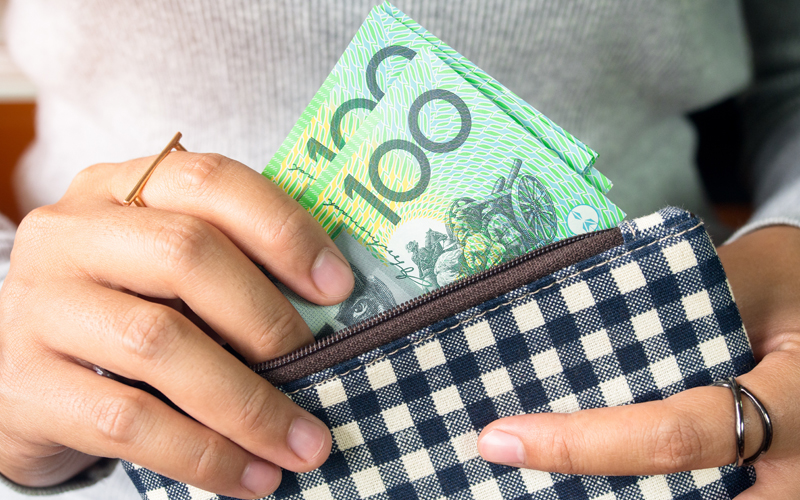As the property industry continues to go from strength to strength, it is becoming harder for Australians to save for a deposit.
The average Aussie has $28,426 in savings, but that varies greatly depending on age and gender, according to the latest figures from Finder.
The report found that young Aussies aged around 23 years were on the lower end of the spectrum, only saving around $10,586. Millennials are holding around $18K in savings, Gen X $26,436 and Baby Boomers $30,162. Women were also smaller savers on average than men.
Ordinarily, Aussies need 20 per cent of a home purchase price for a deposit. An average deposit costs anywhere between $60K – $160K. With less than $30K at their disposal, many Aussies will struggle to achieve their home ownership dreams.
More info: 5 key financial habits of highly effective money savers
Why don’t we have more savings?
Some Aussies believe their savings took a massive hit from the fallout of COVID-19 lockdown. This was due to many being stood down from their jobs or having wage earnings cut in half. However, it may also actually be due to poor budgeting skills and planning for the future.
WATCH: Finance expert Glen James shares 3 tips to stop overspending:
As worrying as it appears, it seems to be the norm not to have a financial safety net, even prior to the global pandemic.
In 2019, the Financial Consciousness Index discovered that a concerning 13.4 million Aussies didn’t have emergency savings to fall back on if they were out of a job.
And nearly 7.5 million admitted they were struggling to pay their bills. They were not able to save regularly, and did not feel like they had sufficient job security.
So how are these people living hand-to-mouth? Are they spending more than they earn?
Is the cost of living too high in Australia?
Many Aussies cite the growing cost of living and low income as the major reasons for their financial difficulties.
According to the ABS, the overall level of prices of goods and services has increased over the past ten years by 23.4 per cent. This is slightly lower than wage growth, which has increased 30.5 per cent over the same period.
Household bills, medical and hospital services, childcare, education, and property rates have also increased tenfold.
It’s doable: 5 easy ways to change your money mindset forever
The reasons for these price increases are diverse and based mostly around demand and changes to industry standards.
Now, as Aussies try to escape the clutches of the global pandemic, their dreams of home ownership could also slowly slip away if they don’t change their savings strategies.
With property rises continuing to rise faster than incomes, the latest Household, Income and Labour Dynamic in Australia (HILDA) report discovered that despite the rise of numbers of people with mortgages, the rate of home ownership has fallen to 63.9 per cent.
As a trend, home ownership has been on the decline through the generations. In the early 70s, 27 per cent of 20-somethings owned a house. This figure was only 16 per cent in 2018.
How can Aussies save more?
Getting into the habit of saving more money after each paycheck isn’t exactly easy, especially with any incurred debt over the past year.
However, it’s not impossible to make steps towards a financially free future.
Here are some tips to consider when trying to get in the habit of saving more money.
1. Start small, then build
Give yourself permission to start slow. Try saving 1 per cent of your monthly income, and then increase by 1 per cent each month. The main focus is to establish the habit of saving. Once you maintain sufficient momentum, you can take a look at your budget and figure out the savings opportunities that you may not have immediately noticed, and increase this figure.
More tips here: 5 key financial habits of highly effective money savers
2. Treat your savings account as off-limits
Unless absolutely necessary, try to resist the temptation of dipping into your savings account or any emergency funds. Remember, ideally, you should have three to six months worth of living expenses set aside for emergencies
3. Question all of your purchases
Do I really need this pair of shoes? Should I just eat the food I already have at home instead of getting takeaway? My current phone is still in good shape, do I really need the new model? Whatever your vices are, the point is to stop buying things thoughtlessly. Go full Marie Kondo by asking yourself if your spending is bringing you any happiness (or bringing you closer to your budgeting goals), and if it’s not, cut it.
Try this: 3 simple tips to stop overspending
4. Account for extra expenditures
One common reason so many people make it to the end of the month and wonder where all their money went is that they don’t account for extra expenditures. A coffee here, a parking meter there- it all adds up. Take note of the small purchases, because they add up to a big hit to your budget.
5. Keep your budgeting goals realistic
Saving money often means making sacrifices, and it can wear you down after a while. If your self-imposed restrictions on spending are too restrictive, you may be setting yourself up for failure. Ensure you are allowing yourself enough budget to maintain a decent quality of life. Saving is important, but it shouldn’t put a damper on your daily life.
6. If you do have a mortgage, negotiate a better rate
In many cases, some emerging lenders and neobanks can offer competitive rates and better offerings than the traditional Big 4. However, if you’re happy with your current lending provider, don’t be afraid to negotiate a better deal and lower mortgage interest rate.





























Trending